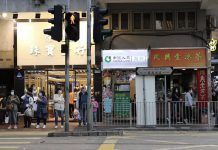Patchy service in private elderly homes and long waiting list for public homes rooted in lack of comprehensive elderly care policy
Reporter: Christine Tai, Krizto Chan
Brian Chan Chi-kin sits with his mother, 84-year-old Yao Si, in a small cubicle in a private home for the elderly in Tsuen Wan. The home is on top of a shopping mall, on the second floor of a high-rise building. Inside the décor is slightly worn and shabby and the air smells stale.
Chan’s mother is happy here, although he admits he was once dissatisfied with the service. Chan says he yelled at the staff during one of his earlier visits. “I thought they were mistreating my mother when we were being ignored for so long after we asked them to change her diaper,” he says.
His mother defended the staff. “She tried to explain how hard it is for the staff to take care of so many people at the same time…I don’t know. I mean I was furious.” Chan shrugged as he recalled the situation.
Yao says she does usually have to wait a while before staff can respond to her requests. “But then you really can’t blame them. . .after all you know they have their limitations. They each have to take care of more than thirty patients here. It is quite hard work for them actually.”
 Her son admits he used to have a bad impression of elderly homes, especially after reading news reports about their shoddy treatment of the elderly people in their care. Recent news reports tell of old people being abused, strapped into their beds and even being forced to eat excrement.
Her son admits he used to have a bad impression of elderly homes, especially after reading news reports about their shoddy treatment of the elderly people in their care. Recent news reports tell of old people being abused, strapped into their beds and even being forced to eat excrement.
But his perceptions are changing.” I mean my mother is a resident in one, she should know best. If she is happy, then I am fine with it.”
Cases of abuse aside, many homes for the elderly do face difficulties and struggle to provide decent services.
At the root of many of the problems is understaffing. Theresa Tong Leong-kwan has been working on the frontline in elderly services for more than 18 years and is now the warden of Angel’s Health Care, a private home for the elderly. She says the understaffing problem has been around for years. “That is why it is difficult to improve the service quality. I used to feed three elderly people at the same time.”
The understaffing problem is exacerbated by a poor perception of nursing work at residential homes. It is considered “dirty work” and hard labour. The turnover rate is high among staff at care homes.
The closure of nursing schools and switching nursing training to universities in recent years has intensified the manpower pressure. Holders of nursing degrees feel they have better options than working in homes for the elderly. Hospitals also face a shortage of nursing staff and are more attractive places to work.
The introduction of the minimum wage also means there are many other jobs in the same salary range and frontline elderly care workers at elderly homes often leave their jobs for better ones.
“Many colleagues quit after the $28 minimum salary policy. They would rather work at restaurants than doing this ‘dirty job’ here in an elderly home. It is less demanding elsewhere,” says Danny Chan Ka-ming, the warden of Wah Fung Nursing Centre, a large private home for the elderly with 557 beds.
Currently, the guidance from the government suggests a ratio of one nurse to 30 residents. Chan says this is, “an impossible ratio” because many residents require a great deal of attention and medical care. The government’s recommendation does not provide for enough carers to give the care the elderly need.
Yet many care homes are too short of staff to fulfil even this requirement.
Chan says he cannot solve the problem by raising the salary of frontline staff.
The Wah Fung Nursing Centre charges between HK$5,500 and HK$8,000 a month for each bed. Chan says the home has a monthly income of around HK$1.5 million.
“Sounds like a lot, right?” he says, “Okay, here is the expenditure breakdown: $1.2 million on the salaries for the one hundred staff, seven hundred thousand dollars on rent, one hundred and twenty thousand dollars on electricity. . .you do the maths. This is reality, and I haven’t even got to insurance, necessaries and other expenditure.” Chan says he faces a deficit every month.
The shortage of financial support hinders the provision of better services while the aging population has put enormous financial pressure on the government, especially in the past 10 years.
According to the Census and Statistics Department, around one in every eight people in Hong Kong is aged 65 or older. This is expected to climb to around one elderly person in every four people by the end of 2030.
Professor Alex Kwan Yui-huen, the head of the Department of Applied Social Sciences at City University of Hong Kong, says demand far outstrips supply in the provision of elderly services. He says some homes are even illegally hiring foreign domestic workers to solve their staffing problems, but adds that does not help. “It will get even worse as there has been no increase in resources, while the demand for these services has risen steadily,” he says.
The demand is so great that it means that each old person has to wait at least two to three years before they are offered a place at a government-funded elderly home. Theresa Tong of Angel’s Health Care says, “Some have even reported waiting for seven to eight years and last year there were 7,000 elderly people waiting in line for a place at the government funded homes.”
Critics say the number of government-subsidized beds in homes, which charge about $2,000 a month and have higher quality of service generally, is not enough. A bed in a private-sector home can cost up to HK$8,000 a month and service quality can be inconsistent and unpredictable.
“I heard that government-funded ones are way better, so I went for that. But I have been waiting fo r almost three years now and there is still no reply. I bet that till the day I die they[the government funded elderly homes] will still be unavailable,” says 76-year-old Au Gou-mei.
r almost three years now and there is still no reply. I bet that till the day I die they[the government funded elderly homes] will still be unavailable,” says 76-year-old Au Gou-mei.
Professor Kwan of City University is one of the critics of the government’s policy for the elderly. He says Hong Kong’s welfare policy does not cater for the long-term care of the city’s rapidly expanding elderly population.
Kenneth Chan Chi-yuk, first chairman of the Elderly Services Association of Hong Kong, describes the problem as a deep-rooted one because the only financial aid available to the elderly in relation to private care homes is the Comprehensive Social Security Assistance (CSSA). Yet the CSSA was never designed to meet the needs of the elderly in long-term care, it was meant to provide a safety net for the most needy.
Under the current system, an elderly person may receive up to HK$5,800 a month based on a medical assessment, which can be used to pay the monthly fee for a private home. This means the recipient can only purchase services of up to HK$5,800.
Explaining the flaws in the system, Chan says, “An elderly person cannot choose the $7,000 service plan of better quality by taking a $5,000 subsidy from the government and paying the remaining $2,000 by himself (or his family). Otherwise, the government will reduce the amount he can get to $3,000 because the elderly person can afford $2,000 more.”
Eighty per cent of the elderly who lives in care homes are claiming CSSA payments. It restricts them their choice of home and, at the same time, it increases the burden private homes for the elderly because their income is limited but their expenses depend on changing factors such as rent, the cost of utilities and wages.
In his Policy Address last month, Chief Executive Donald Tsang proposed an extra supplement for the elderly living in private homes “to ease their financial burden”.
The Elderly Services Association’s Kenneth Chan describes provisions in the Policy Address as a breakthrough because the government acknowledged there was a problem with the system for the first time.
However, he is disappointed that subsequent reports show the government is proposing the supplement should be HK$250. “How did they calculate this? They are not addressing the real problem,” says Chan.
Chan points out that the real cost of providing a place at a public-subsidized home is HK$15,000 a month. Yet private elderly homes are expected to provide services for around HK$6,000, including the new supplement.
“What do they expect a private company to provide for that price?” asks Chan.
Behind the headlines of real neglect and abuse at some private homes there are frontline carers working in challenging conditions and with few resources.
For Peter Chan Chi Kai, 19, whose grandmother is living at a private home, the negative perception of care homes is unfair. At his grandmother’s home, he says, “The staff really know the patients well. I can tell they are not faking it . . .I feel comfortable having them taking care of my grandmother.”
The answer to the elderly care problem lies not in just recruiting and keeping staff such as those Peter Chan admires, it also involves devising comprehensive policies to ensure a dignified life for Hong Kong’s increasing number of senior citizens.










































